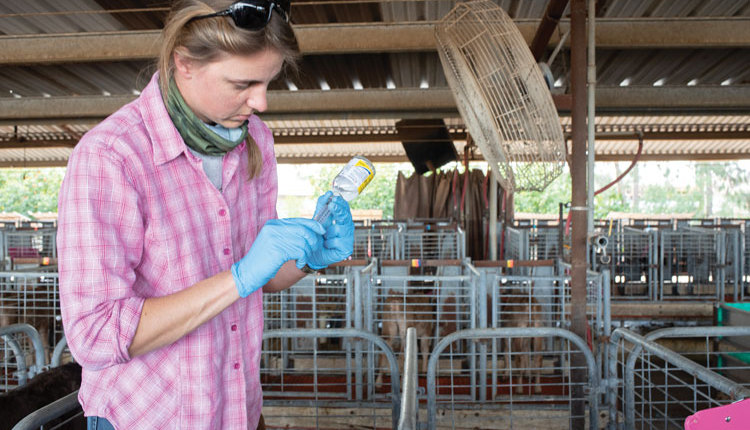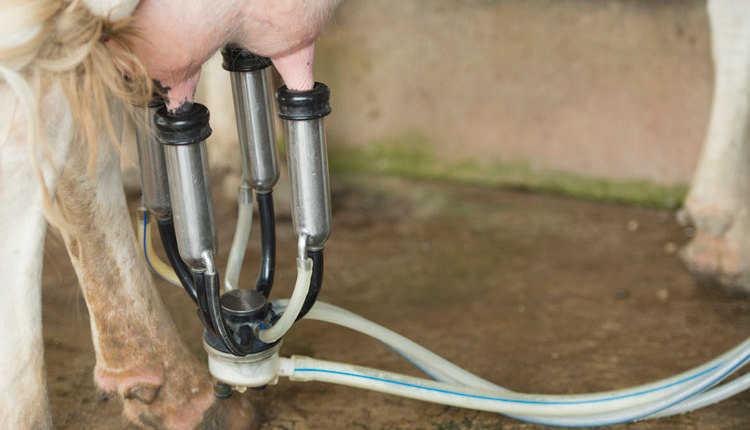
A dairy is only as strong as its weakest link. When it comes to facilities, each building plays an integral role in health and comfort. Just one poorly designed area can hold a herd back from reaching top performance.
For parlor-milked cows, the day involves at least two trips to the milking center and, in turn, at least two trips to the holding area. The holding area is often given little thought, yet cows spend precious minutes, if not hours, standing in this space waiting to be milked.
Poor holding area design can be a major cow comfort issue; it can also be a location of tremendous heat stress. University of Wisconsin School of Veterinary Medicine professor Nigel Cook, D.V.M., was part of a field trial looking at the relationship between reproduction and heat stress. Statistical modeling revealed that more significant design and cooling factors in holding areas than in freestall barns contributed to heat stress in milking cows. For this reason, farms must think about holding areas as a risk area for cows.
Get it right from the start
To enhance both cooling and comfort, the holding area must first be designed correctly. Recommendations are available on The Dairyland Initiative website. For starters, size a holding area to accommodate the largest group of cows, with consideration for future herd growth. Aim for 15 to 20 square feet per cow.
The benefit of more space is twofold. First, it allows room for cows that wish to lead the group into the parlor to work their way to the front. Cows that lead the group to the holding area are not necessarily the same cows that lead into the parlor. Extra space also allows more airflow and reduces heat stress.
The parlor and pens should be balanced so that cows spend no more than 60 minutes per milking and 2.8 hours per day away from feeding or resting areas. Many farms miss the mark on this one. A 2012 survey of Wisconsin farms showed that average time away from the pen was 90 minutes per milking.
The floor should be sloped upward to encourage cows to stand facing the parlor entrance, but that slope should not exceed 2 percent to avoid stress on rear feet. An especially steep decline in the return alleys could also cause slipping and excessive claw wear. Concrete floors should have a parallel groove running lengthwise through the holding area. The grooves should be 3/4-inch-wide, 1/2-inch-deep, and spaced 3-1/4 inches on center.
Rubber flooring can be added for more cushion and traction. Rubber that has greater compressibility is ideal for the holding area.
Time to chill
The addition of heat abatement is another step toward making the holding area a safe place for cows to congregate. On most dairies, natural ventilation is used to move fresh air into the holding area while recirculating fans create air velocity. This can work well if the holding area is exposed to prevailing winds and if there is a sufficient number of fans.
More often, though, the holding area is located near other buildings that do not allow for good natural ventilation. Also, during periods of calm conditions, farms can't rely on natural ventilation alone. If fresh air doesn't come in, the fans can only recirculate air that is already in the building.
It's no surprise holding areas heat up quickly. Ken Nordlund, D.V.M., with the University of Wisconsin School of Veterinary Medicine, shared that a cow producing 100 pounds of milk a day generates the same amount of heat as a 1,500-watt space heater. So, 100 milk cows in a holding area are equal to running 100 space heaters in that same room.
Nordlund explained that, most of the time, standing allows cows to cool down. Two summers ago, the School of Veterinary Medicine did a heat stress trial in July. The cows gained heat when they were lying down, but almost any time they stood up they lost core body heat. The exception? The holding area.
Norlund explained that this data further supports that holding areas are a risk area for elevated body temperatures. "The hotter the cow is coming out of the holding area, the less time she can lie down in the pens," he said. "And there are consequences to less lying time . . . it's all going to come back to milk yield, appetite, and lameness rates."
More directed airflow
Over the past few years, positive pressure tube ventilation systems have become quite popular in calf housing. These systems are designed to bring in fresh air to be distributed evenly throughout the barn, providing a precisely measured amount of air to each animal.
More recently, the University of Wisconsin looked into using positive pressure tubes to deliver fresh air to the holding area. With the tubes, the ventilation target is 60 to 90 air exchanges per hour. The goal is an entire holding area covered with fresh air.
According to Nordlund, the simplest installation is to mount fans along the side of the building and run tubes across the holding area. Tubes would run perpendicular to the direction of cow movement.
If utility rooms, restrooms, or offices prevent a perpendicular formation, there are ways to install tubes to run down the length of the holding area while still drawing air from the sides. If necessary, tubes can be designed to run lengthwise, but longer tubes mean less air can be discharged per square foot, sometimes resulting in insufficient cooling.
Fans designed specifically for positive pressure tubes are preferred. These fans have a housing that allows for easy attachment of the flexible tube and are designed to operate at a significant static pressure. Most holding area systems utilize 30-inch tube fans.
The diameter of the tube is dependent on fan capacity and desired velocity. A 30-inch fan will typically require a tube 38 to 40 inches in diameter to achieve uniform discharge of air. Polyethylene is the lower cost material, but select vinyl if the tubes are exposed to significant direct sunlight.
A challenge in a holding area positive pressure ventilation system is keeping the tubes high enough so cows can't reach them, but low enough to provide adequate airflow. Often, the determining factor for tube height is the crowd gate. The optimal distance between the floor and the bottom of the tube is 10 feet or less. It is difficult to achieve an efficient and effective cooling system where the bottom of the tube is 12 feet or more above the floor.
It takes careful design to ensure that a positive pressure system can meet the ventilation requirements of a building. Just any tube with holes in it won't do. A list of certified consultants and other helpful resources can be found on The Dairyland Initiative webpage. Utilize these experts to help design a ventilation system that works for you and your cows.
"Positive pressure ventilation systems are fairly new to the game," said Nordlund, noting that there are likely less than 25 operating in the world right now. However, evenly distributed airflow in combination with sprinklers can make trips to the holding area more pleasant for the entire herd.
For more information on holding area heat abatement, visit The Dairyland Initiative website at TheDairylandInitiative.vetmed.wisc.edu.
160525_353










